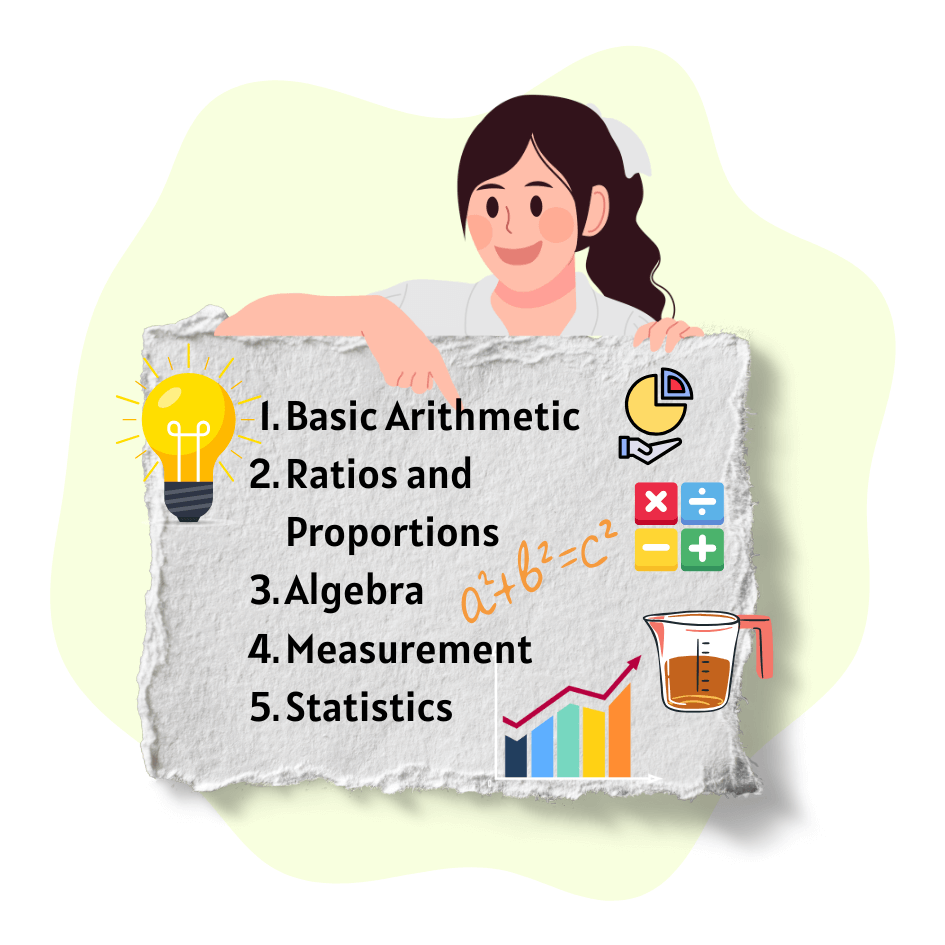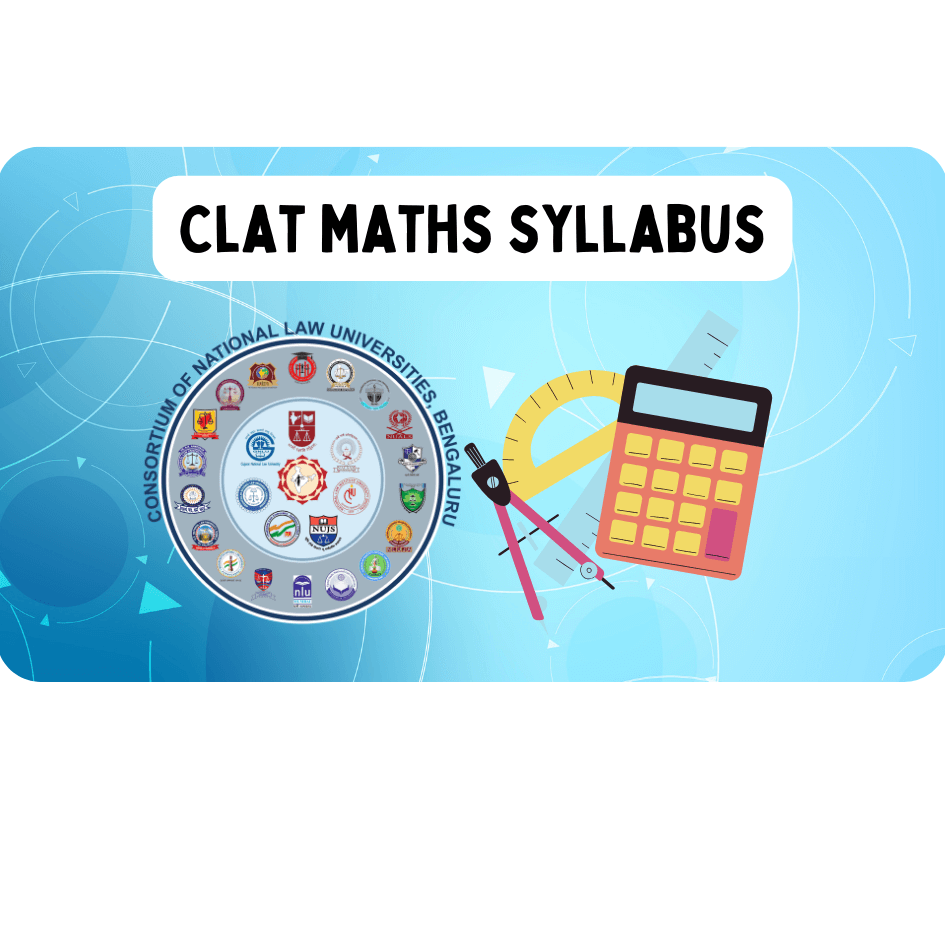The CLAT (Common Law Admission Test) is a key examination for those aiming to pursue undergraduate and postgraduate legal studies in India. Among its various sections, the Quantitative Reasoning segment holds significant importance, assessing candidates’ ability to interpret and manipulate numerical data effectively. A strong understanding of the CLAT Maths Syllabus is crucial for performing well in this section.
Like the previous year, the Quantitative Techniques syllabus for CLAT 2026 will likely focus on understanding and utilizing numerical and visual data, alongside basic math concepts from up to the 10th grade. This segment is designed to evaluate how well candidates can apply mathematical operations and interpret data presented in graphs, charts, and diagrams.
Questions in the CLAT Maths Syllabus often require candidates to perform mathematical operations based on the information provided. The ability to process and interpret this data correctly is essential for answering the questions accurately. The Quantitative Techniques section is considered one of the highest-scoring and deal-breaking areas in the CLAT exam. Therefore, a thorough understanding of the CLAT Mathematics Syllabus 2026 can significantly improve your overall score and rank.
CLAT Maths Syllabus 2026: Key Information and Preparation Tips

The CLAT Maths Syllabus 2026 plays a crucial role in the CLAT exam, accounting for 10% of the total weightage. This section tests your ability to derive, infer, and manipulate numerical data, making it vital for a strong performance in the exam.
With around 20-25 passages to read in just 120 minutes, time management is crucial during the exam. Practicing with sample questions and previous years’ papers is essential to develop speed and accuracy. Regular practice will help you become familiar with the format and improve your problem-solving skills.
Here’s a detailed look at the important aspects of the CLAT Maths Syllabus 2026:
|
Aspect |
Key Information |
|
Weightage in Exam |
Contributes 10% to the total score |
|
Question Format |
A series of data sets, graphs, or other visual aids followed by related questions |
|
Skills Assessed |
Ability to interpret, analyze, and apply basic mathematical operations up to the 10th grade |
|
Main Topics |
Percentages, Ratios, Proportions, Basic Algebra, Measurement, Estimation in Statistics |
|
Level of Difficulty |
Questions based on Class 10th mathematics |
|
Scoring System |
Correct answers earn 1 mark; 0.25 marks are deducted for wrong answers |
CLAT Maths Syllabus 2026 Concepts
The CLAT Maths Syllabus 2026 is designed to assess candidates’ ability to work with numerical data, apply mathematical operations, and solve problems effectively. The syllabus is divided into two main areas: Understanding Numerical Information and Mathematical Operations and Concepts. Below are the important topics to focus on:
Data Interpretation and Analysis
- Data Extraction from Passages: Candidates must extract key numerical information from text-based passages, enabling them to apply mathematical reasoning to solve related questions.
- Graphs and Diagrams Interpretation: Understanding and analyzing data presented in various graphical formats, such as bar graphs, line charts, and pie charts, is an essential skill.
- Data Representation: Candidates will be expected to work with numerical data shown in different formats like tables, charts, and diagrams, requiring accurate interpretation and manipulation of the data.
Mathematical Concepts
- Basic Arithmetic: Proficiency in addition, subtraction, multiplication, and division is crucial for solving problems efficiently.
- Ratios and Proportions: A strong grasp of ratios and proportions and how to apply them in different problem contexts.
- Algebra: Understanding algebraic expressions, solving equations, and dealing with inequalities.
- Measurement: Applying concepts of measurement in practical scenarios, including length, weight, volume, and time.
- Statistics: Interpreting statistical data and understanding measures like mean, median, mode, and standard deviation.
Key Topics in CLAT Maths Syllabus 2025
|
Topic |
Description |
|
Basic Arithmetic |
Involves operations like addition, subtraction, multiplication, division, and key concepts such as number system, decimals, fractions, approximation, roots, surds, indices, HCF, LCM, average, ratio and proportion, time and work, simplification, logarithms, and functions. |
|
Commercial Mathematics |
Focuses on topics such as percentage, interest calculations, discounts, partnerships, profit, and loss. |
|
Modern Mathematics |
Includes concepts like clocks, calendar, and probability. |
|
Mensuration |
Covers the measurement, volume, and geometry of different shapes and solids. |
|
Algebra |
Deals with basic algebra concepts and their applications in problem-solving. |
Top Preparation Strategies for CLAT Maths Syllabus 2026
To perform well in the CLAT Maths section, a strategic approach is essential. Effective preparation ensures that you understand the underlying concepts and are able to solve problems quickly and accurately. Here are some strategies that can help you excel in the CLAT Quantitative Techniques section:
- Strengthen Your Foundation:
Revisit key mathematical concepts from the basic school syllabus, particularly in arithmetic and algebra. These core topics form the basis of the CLAT Maths Syllabus 2026 and mastering them will help you build confidence as you tackle more challenging problems.
- Develop Problem-Solving Techniques:
Each topic in the CLAT Maths Syllabus requires its own set of problem-solving methods. Take time to learn and practice these techniques so that you can apply them effectively when solving different types of questions.
- Consistent Practice:
Regular practice is crucial for honing your mathematical skills. Work through a wide variety of questions from mock tests and previous year’s papers. This will not only improve your ability to solve problems but will also help you work efficiently under time pressure.
- Master One Topic at a Time:
Rather than jumping between topics, focus on mastering one subject at a time. Ensure you fully understand the basic principles and complete plenty of practice questions before moving on to the next topic. This method helps reinforce learning.
- Improve Your Time Management:
Effective time management is essential for the CLAT exam. Practice solving questions within a limited time frame to simulate exam conditions. This will help you work more efficiently and manage your time better during the actual test.
- Learn from Your Errors:
Review the questions you got wrong during practice and try to understand why you made those mistakes. Focus on areas where you struggled, and keep practicing those topics to improve.
- Seek Help When Needed:
If you’re struggling with specific concepts, don’t hesitate to ask for help. Consult teachers, mentors, or use online resources to get clarification on difficult topics or problems.
- Simulate Real Exam Conditions:
To prepare for the CLAT exam, take regular mock tests. This will not only help you get familiar with the CLAT exam pattern but will also allow you to practice time management and assess your performance under exam-like conditions.
In conclusion, consistent effort, smart strategies, and focused practice are vital to succeeding in the CLAT Maths section. By sticking to these preparation tips and giving extra attention to key topics, you will boost your performance in the CLAT Maths Syllabus 2026 and improve your chances of achieving a high score.
Best Books to Prepare for CLAT Maths Syllabus 2026
For effective preparation of the CLAT Maths Syllabus 2026, refer to the following books to ensure you cover all the necessary topics as per the latest syllabus:
- Quantitative Aptitude by R.S. Aggarwal
This book is an excellent resource for building a strong foundation in quantitative reasoning. It covers all the key mathematical concepts required for the CLAT exam, including basic arithmetic, algebra, and problem-solving techniques. - Magical Book Series: Data Interpretation by BSC Publication
This book focuses specifically on data interpretation, one of the most important topics in the CLAT Maths section. It provides a range of practice problems and solutions to help you master graphical data analysis and interpretation.
Conclusion:
In conclusion, preparing for the CLAT Maths Syllabus 2026 requires a strategic approach and consistent effort. A solid understanding of the core mathematical concepts, including data interpretation, basic arithmetic, algebra, and statistics, is crucial for achieving a high score in the Quantitative Techniques section. By following the right preparation strategies, practicing regularly, and using recommended resources, you can enhance your problem-solving skills and time management, ultimately improving your overall performance in the exam. Stay focused, practice diligently, and approach each topic one at a time to maximize your chances of success in the CLAT 2026.
To Download Monthly Current Affairs PDF Click here
Click here to get a free demo
Discover all about CLAT Exam
